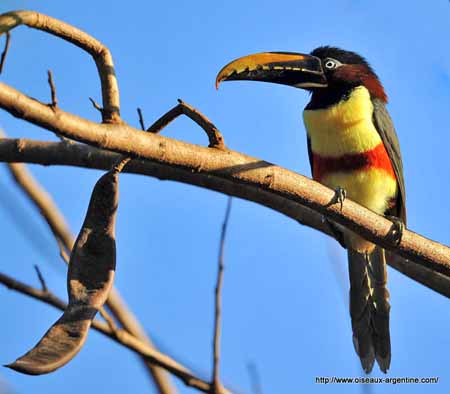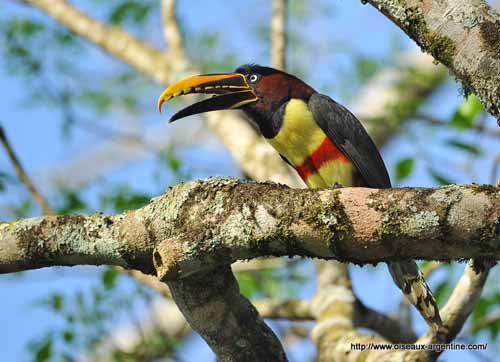
Fr: Araçari à oreillons roux
All: Braunohrarassari
Esp: Arasarí Caripardo
Ital: Aracari orecchiecastane
Nd: Bruinoor-arassari
Sd: Rostörad aracari
Port: Araçari-castanho
Photographers:
Philippe et Aline Wolfer
OISEAUX D'ARGENTINE
Text by Nicole Bouglouan
Sources:
HANDBOOK OF THE BIRDS OF THE WORLD Vol. 7 by Josep del Hoyo-Andrew Elliott-Jordi Sargatal – Lynx Edicions – ISBN: 8487334377
A GUIDE TO THE BIRDS OF COLOMBIA by Steven L. Hilty and William L. Brown - Princeton University Press – ISBN 069108372X
L’ENCYCLOPEDIE MONDIALE DES OISEAUX - Dr Christopher M. Perrins - BORDAS - ISBN: 2040185607
Arthur Grosset's Birds (Arthur Grosset)
BirdLife International (BirdLife International)
Wikipedia, the free encyclopaedia
XENO-CANTO – Sharing Birds sounds from around the world
Chestnut-eared Araçari
Pteroglossus castanotis
Piciforme Order – Ramphastidae Family
BIOMETRICS:
Length: 43-47 cm
Weight: 220-310 g
DESCRIPTION:
The Chestnut-eared Araçari is a bird of wet forest and it is largely frugivorous.
The adult male has dark green upperparts with red rump. Wings and long graduated tail are green too.
The underparts are yellow with red-chestnut band between lower breast and belly. The upperbreast may be slightly washed red. The thighs are cinnamon to chestnut-black.

On the head, crown, nape and lower throat are black. Head side, lower nape and upperthroat are brown to chestnut.
The spectacular bill has broad base with orange-yellow basal line. Mandibles are black, but the upper one shows triangular black culmen and orange-yellow sides. A long, black triangle points from the upper base to the tip. The cutting edge of the upper mandible, or tomial “teeth”, is black and yellowish, and conspicuously serrate. The tip is hooked.
The facial skin is greyish to pale blue. The eyes are whitish. Legs and feet are greenish-yellow.
The female resembles the male but she is browner on the head. The black area of the lower throat is narrower and the bill is shorter.
The immature is duller and the bill pattern is indistinct, and lacks the basal line and the tomial “teeth”.
The race “australis” is paler overall, with green and rusty thighs.
VOICE: SOUNDS BY XENO-CANTO
The Chestnut-eared Araçari main call is a piercing and high-pitched “sneeep” or a longer “psheee-eep”. These sounds are uttered in irregular series.
We can also hear a single “tekk”, a low “eeee-eee”, a call with four whistled “weet” notes and a longer woodpecker-like “pyeee-tyee-tyee-tyee-tyet” which could be a kind of song.
While calling, the bird often twitches and cocks the tail, and throws the head about.

HABITAT:
The Chestnut-eared Araçari frequents mainly wet habitats with lakes and rivers, wet or flooded forests, wooded islands in rivers, swampy forest, gallery forest, edges and clearings.
It can also be seen in plantations, dense bamboo thickets, coffee plantations and woodland patches.
This species is usually seen below 600 metres of elevation, but according to the range, up to 1000-1200-1300 metres along the Andes.
RANGE:
The Chestnut-eared Araçari occurs in the SW of the Amazon Basin. It is also found in E Andean foothills, and the range extends to S and E Colombia.
BEHAVIOUR:
The Chestnut-eared Araçari is a frugivorous species, feeding on fruits from several plant species. However, it may also take flowers and nectar. It catches insects, and is known to hunt nestling birds and it takes eggs too. It preys on nests of some bird species, and may attack woodpeckers, driving them from their holes.
Fruits are taken from the branch, sometimes by hanging upside-down. It searches for food in bark crevices and all cavities in trees. The Chestnut-eared Araçari forages usually in the lower canopy and understorey, shrubs and trees.
These birds usually stay well away from the larger toucans, because a hierarchy by size is often established at food sources.
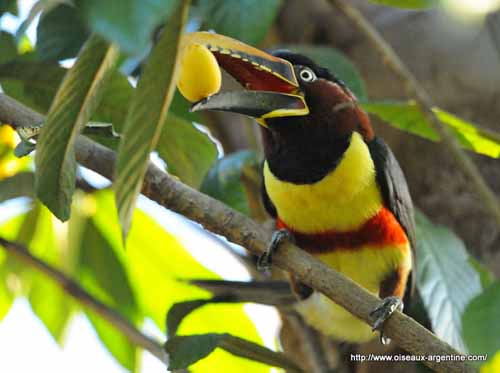
Some displays can be observed during the breeding season.
Both mates bob and bow at one another several times. The red rump feathers are often raised during the displays, and the bill pattern is displayed too.
The Chestnut-eared Araçari performs some movements such as crossing rivers, even large ones. They also move according to the food resources at fruiting trees.
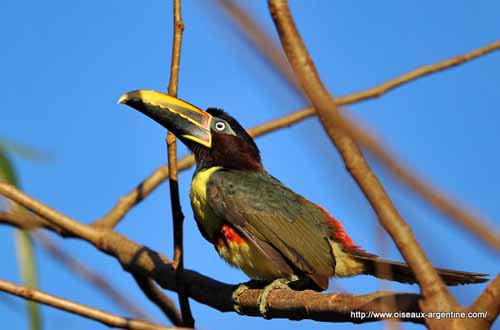
FLIGHT:
The Chestnut-eared Araçari has fairly direct flight performed with rapid wingbeats. The flight is rather weak, with occasionally short glides.
When they are in groups, they fly in single file across the forest openings and clearings, in upper level of trees.
REPRODUCTION:
The breeding season varies according to the range.
The Chestnut-eared Araçari often nests in groups with some other pairs, up to 10-12 birds.
The nest is often placed in old woodpecker hole. This cavity is probably enlarged by excavating, thanks to the large bill.
The female lays 2-4 white eggs. The incubation lasts about two weeks, mainly by the female, but the male may help when she goes out to feed. Both parents feed the chicks. The young fledge one month after hatching and form a family group with the adults.
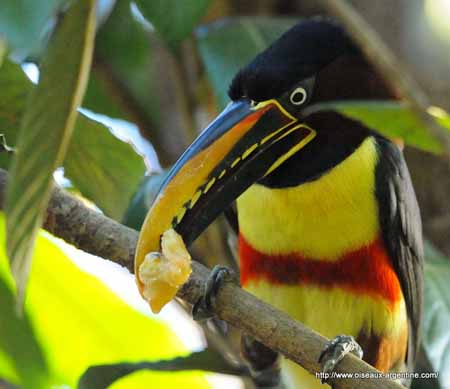
DIET:
The Chestnut-eared Araçari is a frugivorous species, feeding on fruits from several plant species such as Cecropia, Ficus, Ocotea and others. It also consumes flowers and nectar. It may catch insects, but also nestling birds and eggs from Hirundinidae, Fringilidae and Columbidae.
PROTECTION / THREATS / STATUS:
The Chestnut-eared Araçari is fairly common throughout the range, and occurs in several protected areas.
This species is still hunted by humans in some parts of the range.
However, populations appear stable and they are not currently threatened.
